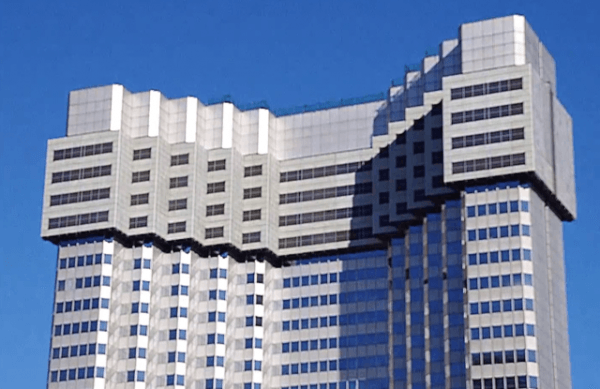We all know about ways to build greener more energy-efficient buildings, but what about the other side of this coin? Is there such a thing as “green demolition”? Many of today’s small buildings are torn down slowly with wrecking balls and earth-moving equipment. Taller structures are more economically brought down by explosives and gravity, becoming eye-popping media events that bring out the destructive inner-three-year-old in all of us.
But what about big skyscrapers — ones that are 25 stories or taller? At those heights, implosions become hard to control and can generate large fields of toxic debris and dust that can damage other structures. A company in Japan called Taisei Corp. said in this Co.Exist article that it has come up with the “Taisei Ecological Reproduction System,” or Tecorep, which essentially demolishes structures from the inside out, slowly chewing the building down to the ground, floor by floor.

Here’s how Tecorep works: After all of the reusable and recyclable materials are removed from the building, the company attaches a structure with cranes and steel beams around the top floor, fitting snugly like a cap. Then, demolition crews begin cutting holes in each floor, providing an open shaft all the way to the foundation. From there, the highest floor and the supporting walls are then dismantled systematically, piece by piece, and winched down the interior shaft. After each floor is removed, hydraulic jacks slowly lower the cap structure to the next floor and the process is repeated all the way to the ground in a matter of months.

What the Tecorep method loses in speed and spectacle, it gains in better safety and cost reductions, Taisei says, as well as other benefits such as noise abatement by 17 to 23 decibels and 90 percent dust reduction. By using regenerative technology on its cranes, the company captures and reuses kinetic energy each time it lowers debris to the ground, thus saving on fuel costs and CO2 emissions.
Currently, Taisei is in the middle of demolishing the 455-foot-tall Grand Prince Akasaka Hotel tower in Tokyo, the largest building the country has ever demolished. Built in 1982, the hotel closed in 2011 and began demolition procedures in June 2012. The project is expected to be completed this spring, the company says. (Check out this cool time-lapse video posted by The Japan Times on YouTube, showing the project’s incremental progress.)
So, how often will this very specific technology be used? According to a recent Japan Times article, Japan alone has nearly 800 buildings that are more than 100 meters high (roughly 328 feet), with about 100 that are between 30 and 40 years old, and will be considered obsolete within the next decade.
While many of today’s super-tall skyscrapers, measuring 1,000-feet-plus, are designed to last for centuries, there are economic pressures may speed up the demolition of lesser structures in pursuit of ever-higher ambitions. A report by the Council on Tall Buildings and Habitat, for instance, found that the number of buildings in excess of 200 meters tall (about 650 feet) jumped from 263 to 756 in the last dozen years. We may have to make more room.